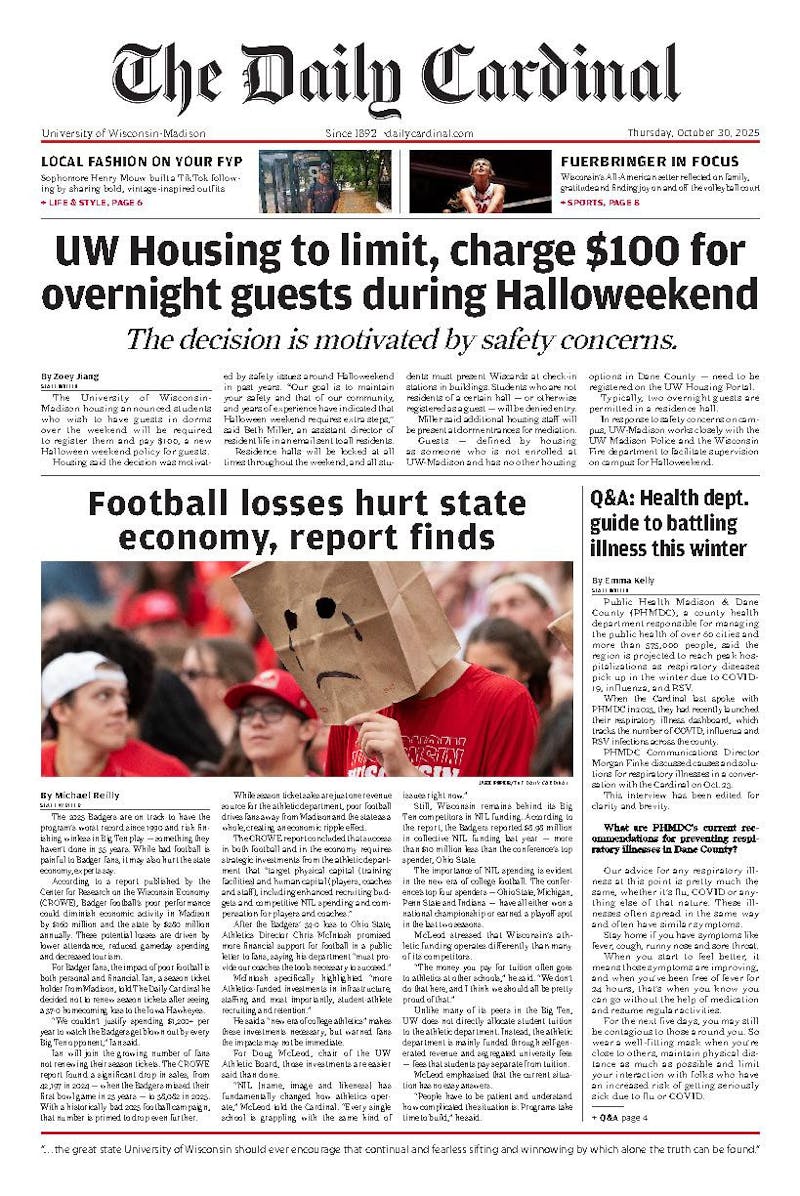Brooklyn Schwoerer, a sophomore at the University of Wisconsin-Madison studying dairy science, lives on a 62-cow farm in Edgar, Wisconsin and is involved in all aspects of the dairy industry.
Schoerer has been showing cows since she was three years old. This year, she got to show her black and white Holstein Barracuda at the annual World Dairy Expo in Madison.
To celebrate dairy’s impact in Wisconsin, the World Dairy Expo brought all things dairy related to the Alliant Energy Center in a large four-day event from Oct. 1 to Oct. 4. With machinery, educational lectures and many exhibitioners showing their prized cows, the World Dairy Expo continues to showcase the large impact dairy brings to not just Wisconsin, but the world.
Dairy farms are an integral part of Wisconsin’s economy, making a $46.5 billion economic impact each year and supporting over 100,000 jobs. With around 5,425 dairy herds, our state greatly depends on the cows as well as the farmers taking care of them.
“Being able to interact and connect with all different kinds of people that share the same passion for dairy cattle as me is extremely rewarding,” Schwoerer said.
Schwoerer’s family’s calves are fed milk until two months of age and then are given calf grain and hay to allow growth and stimulation of the rumen. When calves are eight months old, they will receive haylage or a total mixed ration.
Once a heifer is pregnant, her diet is built to focus on the growth and development of her calf, Schwoerer said. Finally, when the cow freshens, it receives a high-protein diet to allow for the greatest amount of milk production.
And show cows have unique nutritional needs, Schowerer said.
“Show cattle are judged on their presence and appearance in the show ring. A judge looks for a dairy animal to be clean-cut, deep and, most importantly, dairy. [A] low-energy hay and a high-protein diet will ensure that the animal will keep off weight but will still continue to grow,” Schwoerer said.
The process of showing a cow involves many months of preparation. In March, Schwoerer selected her show animals based on mobility, soundness of feet and legs and the style and blending of parts, such as the head into the shoulder and the back into the body. Once the animals are picked, a high-protein diet and pasture access is given to allow for exercise.
Cow hair is also an important part of showing. Schwoerer rinses her animals with cold water at night and washes them every other day. Once a month, she shaves all the hair leaving the topline and belly, creating strong and healthy hair by showtime.
“Before showing, cows need to be clear of any diseases. This includes no ringworm or warts,” Schwoerer said. “This year, lactating cows had to undergo an avian influenza test.”
Fair attendees and exhibitors are at higher risk of infection from animal influenza viruses, but preventative measures such as avian flu testing for each animal and following preventative actions such as hand-washing and avoiding sick animals can prevent the spread.
Cow health and nutrition are critical to showing prized cows, improving human diets
The aspect of showing doesn’t just involve a beautiful cow getting judged in a ring. Cow health and nutrition play a large role in keeping these cows healthy and creating larger milk yields, according to Matt Akins, a dairy scientist and research leader for the U.S. Department of Agriculture’s Agricultural Research Service Dairy Forage Research Center in Marshfield, Wisconsin.
“Nutrition can have great impacts on cow health, including ensuring adequate fiber, energy, protein, minerals and vitamins are provided in the diet to meet the cow’s needs for milk production and maintaining their bodies,” Akins told the Cardinal.
Fiber maintains the health of a cow’s rumen by allowing for stimulation of cow chewing and saliva production, which helps avoid acidic rumen conditions, Akins said. Protein and essential amino acids that are important for a cow’s diet and immune function to help prevent pathogens. Vitamins and minerals, such as zinc for hoof health, selenium and vitamin E for immune function and choline for liver function play key roles in improving cow health.
As with the important nutrients needed for a cow's overall health, their diet also plays a large role in maintaining health and high milk yield, Akins said.
“50 to 70% of the cow’s diet is forage depending on the quality and nutritive value. Forages fed include alfalfa silage or hay, corn silage, grass silage or hay and other fibrous forages needed to ensure good rumen health,” Akins said.
A cow’s diet not only affects the amount of milk they produce, but also the quality of their milk that humans consume. There is a direct relationship between nutrition quality and milk quality in cows, Akins said.
“Cows that are grazed on pasture and consuming fresh forage have been found to have increased levels of carotenoids in the milk and changes in milk fat profiles,” Akins said.
Carotenoids are naturally occurring plant pigments mammals only obtain through their diet. Some carotenoids have been found to increase vitamin A intake, have antioxidant and anti-inflammatory properties and improve ocular and cognitive health.
Milk can drastically improve the vitamin A intake in human diets. Cows that receive a high quality forage diet have increased carotenoid levels in their milk, which therefore affects human consumption.
In order for a cow to receive adequate nutrition, nutritionists play a large role on dairy farms. Akins told the Cardinal nutritionists help balance forages with supplemental feeds to meet nutrient requirements. They also keep up to date with new nutritional research and knowledge to help better a cow’s diet.






